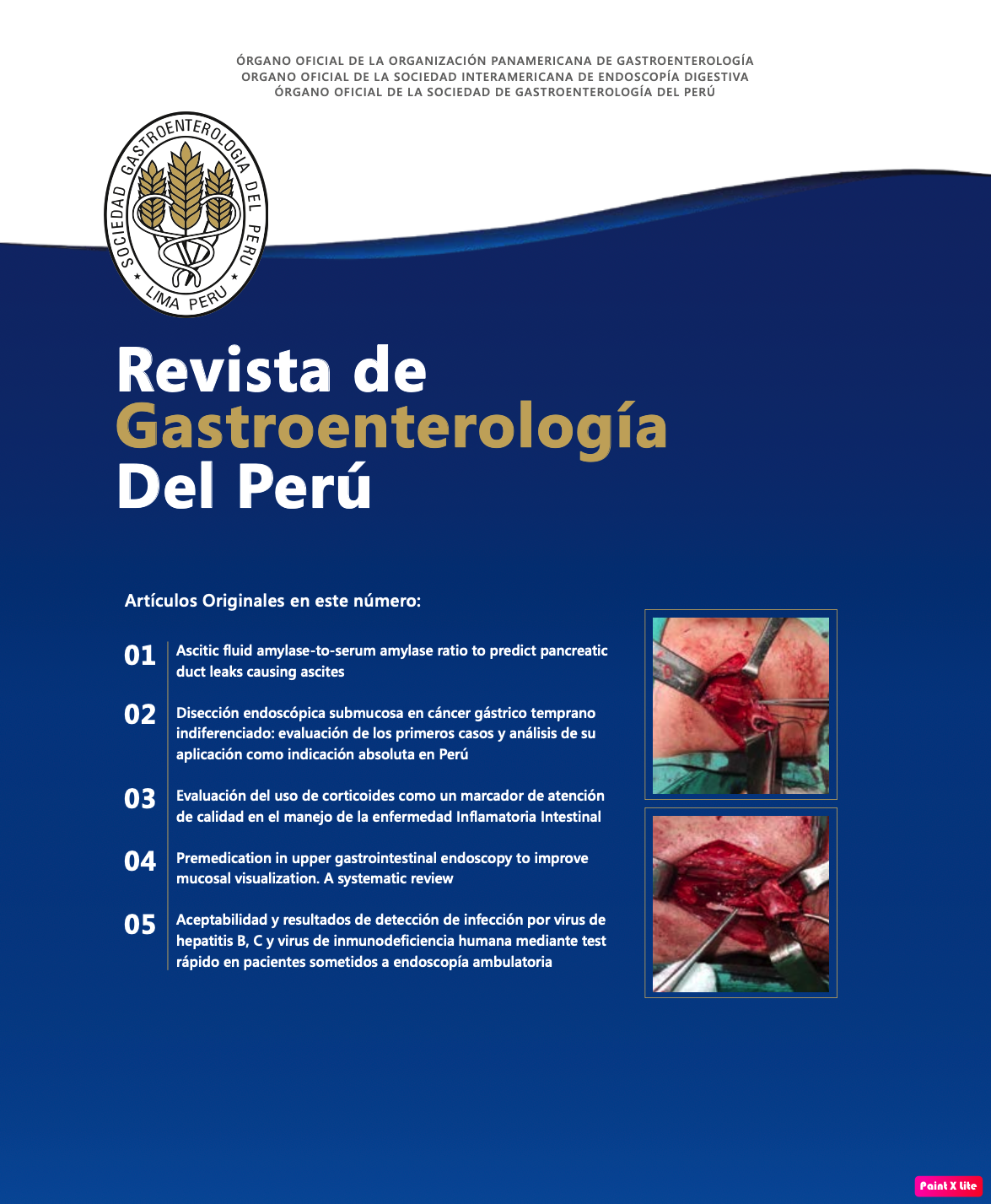Ascitic fluid amylase-to-serum amylase ratio to predict pancreatic duct leaks causing ascites
DOI:
https://doi.org/10.47892/rgp.2024.444.1807Palabras clave:
Cholangiopancreatography, Endoscopic Retrograde, Pancreatic Ducts, AscitesResumen
Objectives: Pancreatic duct leaks can cause ascites, and fluid amylase can be used as a marker to suggest pancreatic duct leak; however, there is no reference parameter or cutoff value for diagnosis. We assessed whether a novel ratio of ascitic fluid to serum amylase can reliably predict pancreatic leaks and need for endoscopic retrograde cholangiopancreatography (ERCP). Materials and methods: Patients who had fluid amylase from ascitic fluid and serum amylase within one week of confirmed pancreatic leaks via ERCP were included along with appropriate medical and surgical controls. Results: A total of sixteen patients were included in the study group. The mean ascitic fluid amylase to serum amylase ratio in the study group was 243, and 0.3511, and 0.9406 for medical and surgical controls respectively. The cutoff ratio to predict pancreatic leaks was 6.89 with 100% sensitivity and specificity (p-value 0.0000000000001347). Conclusions: Patients with a fluid to serum amylase ratio of at least 6.89 should be considered high risk for pancreatic leak with consideration to proceed directly to ERCP.
Descargas
Métricas
Citas
Larsen M, Kozarek R. Management of pancreatic ductal leaks and fistulae. J Gastroenterol Hepatol. 2014;29(7):1360-70. doi: 10.1111/jgh.12574.
Tenner S, Baillie J, DeWitt J, Vege SS. ACG Clinical Guideline: Management of Acute Pancreatitis. Am J Gastroenterol. 2013;108:1400-1415. doi: 10.1038/ajg.2013.218.
Negron-Ocasio GM, Roman PL, Reimon-Garcia L, Ocasio J, Adams Chahin JJ, Vargas-Otero P, et al. S3400 Elevated Ascitic Fluid Amylase? Think Twice It Could Be a Foreshadowing of Intestinal Perforation. Am J Gastroenterol. 2022;117(10S):e2150. doi: 10.14309/01.ajg.0000870240.65233.18.
Chandrasekhara V, Khashab MA, Muthusamy VR, Acosta RD, Agrawal D, Bruining DH, et al. Adverse events associated with ERCP. Gastrointest Endosc. 2017;85(1):32-47. doi: 10.1016/j.gie.2016.06.051.
Gillams AR, Kurzawinski T, Lees WR. Diagnosis of Duct Disruption and Assessment of Pancreatic Leak with Dynamic Secretin-Stimulated MR Cholangiopancreatography. AJR Am J Roentgenol. 2006;186(2):499-506. doi: 10.2214/AJR.04.1775.
van Dongen JC, Merkens S, Aziz MH, Groot Koerkamp B, van Eijck CHJ. The value of serum amylase and drain fluid amylase to predict postoperative pancreatic fistula after pancreatoduodenectomy: a retrospective cohort study. Langenbecks Arch Surg. 2021;406(7):2333-41. doi: 10.1007/s00423-021-
-y.
Hauser G, Milosevic M, Stimac D, Zerem E, Jovanović P, Blazevic I. Preventing post-endoscopic retrograde cholangiopancreatography pancreatitis: What can be done? World J Gastroenterol. 2015;21(4):1069-80. doi: 10.3748/wjg.v21.i4.1069.
Poley JW, Heisterkamp J, Dees J, Haringsma J, Eijck CHJV, Kuipers EJ. Endoscopic Pancreatic Duct Decompression in Treating Pancreatic Leakage: A Successful and Safe Method. Gastrointestinal Endoscopy. 2006;63(5):AB312. doi: 10.1016/j.gie.2006.03.844.
Descargas
Publicado
Cómo citar
Número
Sección
Licencia
Derechos de autor 2024 Reid Wasserman, Ahmed Ali Al Qaffas, Peter Darwin, Klaus Mönkemüller, Patrick Okolo, Paul Yeaton, Vivek Kesar, Varun Kesar

Esta obra está bajo una licencia internacional Creative Commons Atribución 4.0.
Revista de Gastroenterología del Perú by Sociedad Peruana de Gastroenterología del Perú is licensed under a Licencia Creative Commons Atribución 4.0 Internacional..
Aquellos autores/as que tengan publicaciones con esta revista, aceptan los términos siguientes:
- Los autores/as conservarán sus derechos de autor y garantizarán a la revista el derecho de primera publicación de su obra, el cuál estará simultáneamente sujeto a la Licencia de reconocimiento de Creative Commons que permite a terceros compartir la obra siempre que se indique su autor y su primera publicación esta revista.
- Los autores/as podrán adoptar otros acuerdos de licencia no exclusiva de distribución de la versión de la obra publicada (p. ej.: depositarla en un archivo telemático institucional o publicarla en un volumen monográfico) siempre que se indique la publicación inicial en esta revista.
- Se permite y recomienda a los autores/as difundir su obra a través de Internet (p. ej.: en archivos telemáticos institucionales o en su página web) antes y durante el proceso de envío, lo cual puede producir intercambios interesantes y aumentar las citas de la obra publicada. (Véase El efecto del acceso abierto).

















 2022
2022 